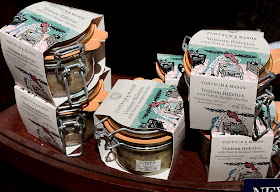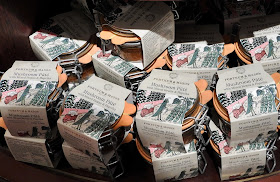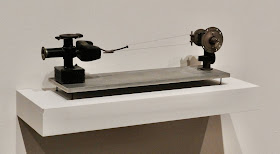目次 / Contents
1) 8月26日 / 26th of August
2) Takis 展、9月6日 / Takis Exhibition, 6th of September
A. 最大の展覧会 / Largest Exhibition
B. 動的に / To the Kinetic
C. 目に見えないもの / Invisible
D. 浮遊 / Floating
E. 音と沈黙 / Sound and Silence
F. 光と暗闇 / Light and Darkness
1) 8月26日 / 26th of August
 |
8月26日
8月26日に夫R とテート・モダンへ行った際に、
ですが、その日は、
ナタリア・ゴンチャロワ / Natalia Goncharova 展: ★と
26th of August
When I went to Tate Modern with my husband R on 26th of August,
I saw the poster of Takis Exhibition :★.
That day I visited Natalia Goncharova Exhibition : ★ and
|
ナタリア・ゴンチャロワ 展は下記。/ Natalia Goncharova Exhibition is below.
↓
オラファー・エリアソン展は下記。/ Olafur Eliasson Exhibition, below.
↓
2) Takis 展、 9月6日 / Takis Exhibition, 6th of September
A. 最大の展覧会 / Largest Exhibition
英国滞在が一週間を切った、この日、最初にロンドンのトワイニング本店で行き、次にテート・モダンへ行き、Takis展を見ました。
In less than a week in Britain, we went first to the Twinings flagship shop in London and then Tate Modern, viewing the Takis Exhibition.
トワイニング本店につては下記。/ About Twinings flagship shop, below.
 |
タキス / Takis展
タキス / Takis (1925 - 2019) は、ギリシャ人アーティストで、本名は、
Takis Exhibition
This the largest exhibition of Takis's work ever held in Britain,
bringing together over 70 works.
パンフレット
展覧会ガイド → ★(英語)
私はこの展覧会でタキスを初めて知りました。
とても刺激的な展覧会でしたし、私は彼の作品が好きになりました。
なので、タキスの作品集を買いました。
Leaflet
Exhibition Guide → ★
I first knew of Takis by this exhibition.
It was a very exciting exhibition and I fell in love with his work.
So I bought a book of Takis works.
 タキスの作品集 / Book of Takis Works
タキスの作品集 / Book of Takis Works
|
 |
"タキスは電磁宇宙の本質的な詩と美しさを求めました。
彼は1960年代からヨーロッパで最も独創的で芸術的な声の1人であり、
彼の人生を通じて先駆的な人物であり続けました。"
|
|
 |
"この展覧会は年代順ではありません。
代わりに、それはタキスの創造的な宇宙を形作るテーマによって配置されます:
磁気と金属、光と闇、音と沈黙。
また、ヨーロッパと米国全体の創造的で科学的なコミュニティとの彼の重要な関与を強調しています。"
|
 |
"This exhibition is not chronological.
Instead it is arranged by themes that shape Takis’s creative universe :
magnetism and metal, light and darkness, sound and silence.
It also highlights his critical involvement with creative and scientific communities across Europe and the United States."
|
 |
タキスは20才の頃、パブロ・ピカソ (1881 - 1973) と
アルベルト・ジャコメッティ (1901 - 1966)の作品に影響を受けました。
これらの作品にその影響が感じられます。
When Takis was around 20 years old, he was influenced by the works of
Pablo Picasso (1881 - 1973) and Giacometti (1901 - 1966).
The influences can be felt in these works.
 |
1954年、タキスは、アテネからパリに移り、鍛造、溶接、鋳造の方法を学びました。
パリで彼は、動的彫刻に実験を行っていたイヴ・クライン (1928 - 1962) やジャン・ティンゲリー (1925 - 1991) などのアーティストに会い、静的から動的に興味を移し始めました。
タキスとは話が逸れてしまいますが....。
ティンゲリー 個人として、名前が出てきたのは、私にとっては、初めてでした。
また、今夏、ストックホルム近代美術館で、初めてニキ・ド・サンファルとティンゲリーの共同制作の庭を見ましたし、ティンゲリーの作品を直接見たのも初めてでした。
ティンゲリーの作品は、動的なので、タキスの興味が動的に移行した理由がほんの少しですがわかる気がします。
ストックホルム近代美術館の庭は下記。
To the Kinetic
In 1954, Takis moved to Paris where he learned to forge, weld, and cast metal.
In Paris he met artists like Yves Klein (1928 - 1962) and Jean Tinguely (1925 - 1991) who were experimenting with kinetic sculptures, which began to shift his interest from the static to the kinetic
The story digresses from Takis ....
This was the first time that Tinguely's personal name came out for me, because of his own work.
This summer was also the first time I saw the garden co-produced by Niki de Saint Phalle and Tinguely at the Moderna Museet in Stockholm, and the first time I had seen Tinguely's work in real life
Tinguely's work is kinetic, so I feel I see for a few reasons why Takis' interests have shifted to the kinetic.
About the garden of the Moderna Museet in Stockholm is below.
C. 目に見えないもの / Invisible
1950年代半ばにパリに住んでいる間、彼は電磁気学の彫刻の可能性を探求し始めました。
タキスにとって、彼の作品の「視覚的品質」は無関係でした。
下記、タキスの言葉。
"プラトンは、目に見えない世界を目に見えるものに変えるアーティストについて語っています。
私の彫刻を見ている誰かが彼の通常の状態から持ち上げられることを願っています。"
私も、'目に見えない何か'は好きですし、信じています。
でも彼の目に見えないものは、ずっと具体的な気がします。
Invisible
While living in Paris in the mid-1950s, he started exploring the sculptural possibilities of electromagnetism.
For Takis, the ‘visual qualities’ of his work were irrelevant.
Below are the words of Takis.
"Plato speaks of an artist turning the invisible world into the visible.
I hope that someone seeing my sculpture is lifted out of his ordinary state."
I also like and believe in 'something invisible'.
But Takis's invisible things feel much more concrete.
 |
| 磁石と金属 |
1958年、タキスは肉眼では見えない他のエネルギー、特に磁石を使って実験を始めました。
彼は磁場の磁力とエネルギーを探求し、それが彼の将来の作品の基礎となりました。
In 1958, Takis started to experiment with other energies not visible to the naked eye, particularly magnets.
He explored the magnetic forces and energy of the magnetic fields, which became a foundation of his future works.

磁場 / Magnetic Fields, 1969 |
動画 : ★←ここで吊り下げられた磁石によって動くオブジェが見られます。
Video : ★←Here you can see objects that are moved by hanging magnets.
風に揺れるお花畑のようです。
It's like a flower meadow swaying in the wind. |
 |




ワイヤーで作品が浮遊しているように見せるやり方が
彼の作品の特徴だと思いました。
浮遊しているように見える作品が好きです。
I thought that the way his work was made to look like it was floating
on a wire was a feature of his work.
I like works that look like they are floating.
|

ちょっと笑ってしまう.....
I laugh a little ..... |
 |
D. 浮遊 / Floating
私は、'浮遊'と言う言葉が好きで、多くの浮遊しているものも好きです。
タキスの作品には、浮遊を感じさせるものが多くあり、私を気持ちよくさせてくれます。
また、良い刺激も与えてくれます。
Floating
I like the word 'Floating' and I also like many floating things.
Many of Takis's works make me feel floating, which makes me feel good.
It also gives a good stimulus.
 |
Electro-Magnetic Music
1966
レイアウト感覚が好きです。
I like the layout feeling. |
 |
Rader
1960
 |
 |
Yellow Electron
1966
矢印の振り子部分が動くようですが、私は見ていません。
The pendulum part of the arrow seems to move, but I haven't seen it.
|
 |
Magnetic Wall 9 (Red)
1961 |
 |
Telepainting
1959 - 60 |
 |
Telepainting
1959 |
D. 音と沈黙 / Sound and Silence
 |
私の意図は、自然の現象を私の作品から浮かび上がらせることでした…
自然の中では、すべてが健全です:風、海、昆虫のハミング。
|
 |
"タキスの彫刻は、単音から雷のような合奏曲まで、
さまざまな音を生み出します。
1960年代半ばまでに、タキスは電磁石を使用して意図的に音を作成し始めました。
これらの作品には、ゴングやミュージカルが含まれ、磁石が楽器の弦に対して
金属棒を引っ張って、「宇宙の音」と呼ばれるものを生み出しました。"

作品の前を歩いていると、林の中を歩いているような気持ちになります。
Walking in front of the work makes me feel like I'm walking in the woods.
 |
 |
振動
スタッフが一部を動かすと他がそれに共鳴して部屋全体に音がひびきます。
Oscillation
When the staff moves a part, another resonates with it
and the sound spreads throughout the room.

見るだけの作品が五感を刺激する作品に変わります。
The works that I just see turns into a work that stimulates my five senses. |
E. 光と暗闇 / Light and Darkness
タキスの作品は、周囲と関わりあったり、影響しあったりすることを見せてくれます。
実際、その関わっている部分は、目に見えないけれど、結果は、目に見えてきます。
'光と暗闇'の作品もについても、その関わりを見せてくれます。
私は、ある一面を貫き通すものやことよりも、様々な面を感じさせてくれる作品が好きなのかもしれません。
Light and Darkness
Takis's work shows us how we interact with and influence our surroundings.
In fact, the parts involved are invisible, but the results are visible.
It also shows the relationship between the works of "Light and Darkness".
Perhaps I like works that make me feel various aspects rather than things that stick with one aspect.
 |
Telepainting
1964 |
"タキスが亡くなる1か月前の2019年にテート・モダンで開催された大きな回顧展のために発行されたテート・カタログで公開されたインタビューで、タキスは謎解きの1つとしての彼の役割を説明しています。
「それは、何らかの形で、宇宙に存在する感覚振動またはエネルギーの絡み合う可能性を明らかにすることについてのみです」
と彼は説明します。
「それは、画家でも、彫刻家でも、ミュージシャンでも、アーティストの役割だと思います。
このエネルギーを抽象的なものと見なすべきではないと思います。」"
"In an interview published in the Tate catalogue, issued for the major retrospective held in Tate Modern in 2019, just one month before his passing, Takis explains his role as one of demystification.
'It’s only about revealing, in one way or another, the sensory vibrations or the interlacing potentials for energy that exist in the universe,'
he explains.
'I think that’s the role of an artist, whether painter, sculptor or musician. ' "
タキスの作品集とポストカード
Book of Takis Works and Postcards
 |
Signal
1974- 9 |
この展覧会が見たかったので、テート・モダンへ行きました。
展覧会が私には、とても有意義に感じられ、行ってよかったと思います。
I wanted to see this exhibition, so I went to Tate Modern.
I am glad that the exhibition was very meaningful to me.






















































































